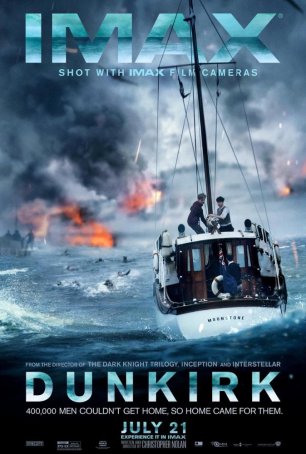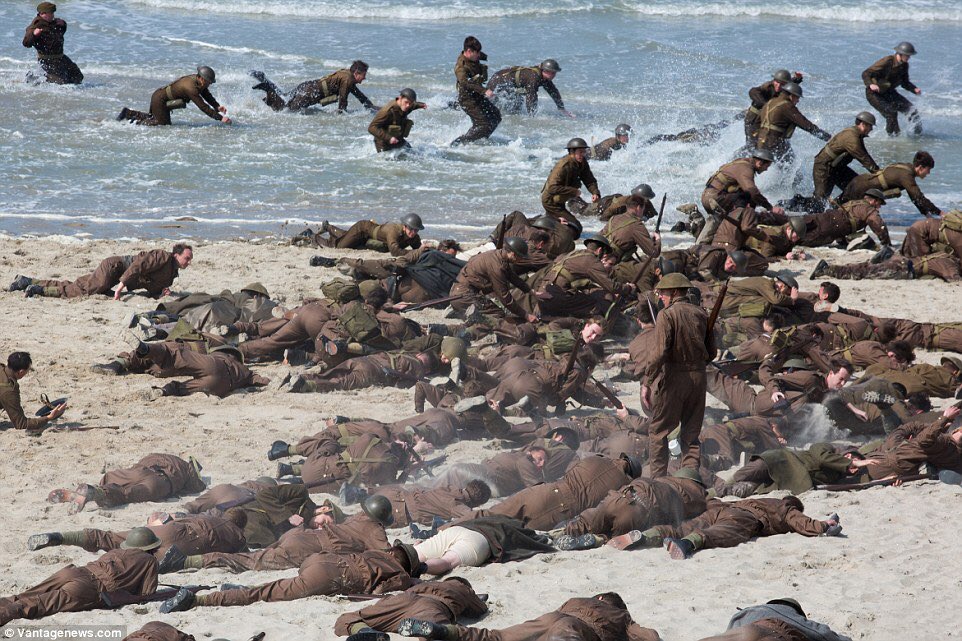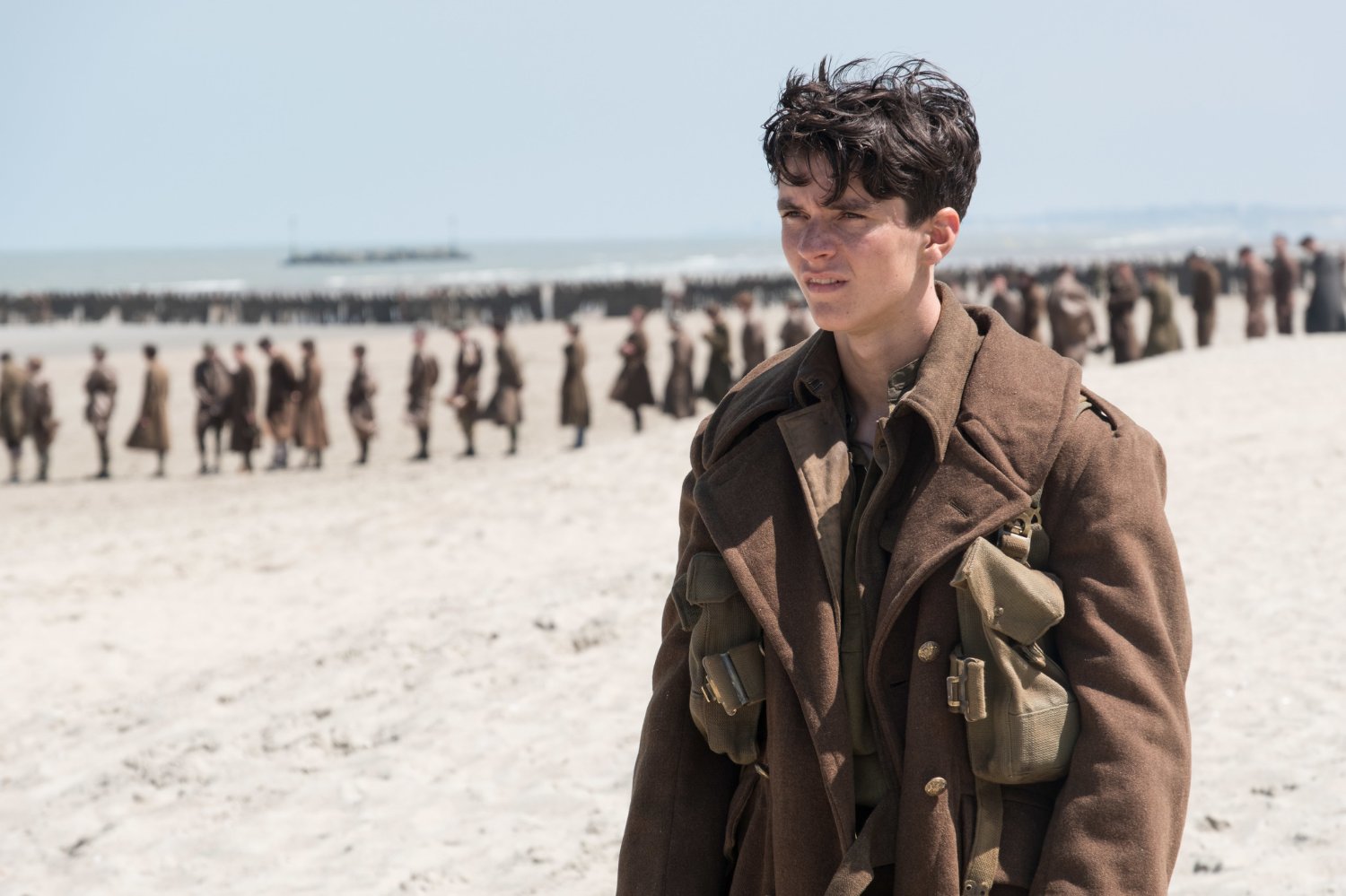Dunkirk (UK/US/France, 2017)
July 18, 2017
Although Dunkirk is technically a war film, its tone and style are those of a high-octane thriller. For his most serious-minded film to date, Christopher Nolan has employed all the weapons in his arsenal to craft something that, despite the Oscar-unfriendly July release date, will almost certainly be remembered when the Best Picture nominations are handed out. If one was to take the Omaha Beach sequence of Saving Private Ryan, remove the most gruesome and graphic images and expand the length to about an hour and a half, that’s a reasonable approximation of what Dunkirk provides in terms of impact and intensity, if not necessarily content. This accomplished, exceptional piece of cinema delivers summer-scale spectacle, albeit without the escapism audiences often crave from blockbuster releases at this time of the year.
The Battle of Dunkirk holds a unique position in the roster of World War 2 conflicts. By any normal measure, it was a crushing defeat for the Allies, a conflict that resulted in mass casualties and equipment loss. Nevertheless, the engagement is often referred to triumphantly by the vanquished, who perceive the evacuation of more than 300,000 soldiers as a testimonial to British resolve. What happened at Dunkirk was so extraordinary that Winston Churchill had to speak out against celebratory notions, cautioning: “We must be very careful not to assign to this deliverance the attributes of a victory. Wars are not won by evacuations.”
 Like Titanic but
with less melodrama and no love story, Dunkirk
uses the framework of meticulously researched historical events as a backdrop
for fictional characters. Employing extensive cross-cutting, Nolan presents the
events of late May 1940 using three perspectives: The Mole (infantry on the
beaches of Dunkirk awaiting evacuation), The Sea (a civilian crossing of the
Channel), and The Air (a spitfire pilot tasked with stopping Germans from strafing
and bombing rescue vessels and defenseless soldiers). Battles can be difficult
for non-documentary filmmakers to depict. By offering the perceptions of a
limited number of characters and varying their roles and participation, Nolan allows
a larger canvas to emerge. He provides enough aerial shots and glimpses of maps
so even those unaware of the geography won’t be lost.
Like Titanic but
with less melodrama and no love story, Dunkirk
uses the framework of meticulously researched historical events as a backdrop
for fictional characters. Employing extensive cross-cutting, Nolan presents the
events of late May 1940 using three perspectives: The Mole (infantry on the
beaches of Dunkirk awaiting evacuation), The Sea (a civilian crossing of the
Channel), and The Air (a spitfire pilot tasked with stopping Germans from strafing
and bombing rescue vessels and defenseless soldiers). Battles can be difficult
for non-documentary filmmakers to depict. By offering the perceptions of a
limited number of characters and varying their roles and participation, Nolan allows
a larger canvas to emerge. He provides enough aerial shots and glimpses of maps
so even those unaware of the geography won’t be lost.
According to Nolan, two films he studied before making Dunkirk were Wages of Fear and Speed. Their influence is apparent. Both excelled in a slow build-up of tension and Dunkirk is unrelenting in that aspect. The way scenes are edited contributes to this, with Nolan cutting, for example, from a tense moment in a plane to an equally tense moment on the beach. He moves slightly backward and forward in time to knit everything together. Hans Zimmer’s score, which is constructed around the ticking of a clock, abets the burgeoning suspense.
The members of the ensemble cast acquit themselves admirably, although no individual performer monopolizes the screen time. This is neither a character-based nor actor-centric movie. The largest number of scenes belong to the relative unknown Fionn Whitehead, whose Tommy represents the everyday soldier stuck on the beach, desperate to find a way home. Mark Rylance, whose Mr. Dawson is driven by patriotic fervor, steers his small yacht Moonstone across the channel. Spitfire pilot Tom Hardy (Farrier) engages in dogfights with German planes to erode Nazi air superiority over western France. Notable supporting performances include pop icon Harry Styles as one of Tommy’s compatriots, Cillian Murphy as a shell-shocked soldier, and Kenneth Branagh as Commander Bolton, the highest ranking British officer on the ground in Dunkirk.
 So what’s wrong with Dunkirk? Very little. The film’s structure and scope
disallow identification with any character. No one’s on screen long enough to
allow for that. Instead, we react emotionally to moments of exhilaration and tragedy on a large scale. There were
times when I had difficulty understanding the dialogue; the ambient noise and
music drowned out the words. (I am unable to say whether this was the sound
mixing or a problem with the venue where I saw the movie. Considering Nolan’s
reputation for attention to detail, it may well have been the latter.)
So what’s wrong with Dunkirk? Very little. The film’s structure and scope
disallow identification with any character. No one’s on screen long enough to
allow for that. Instead, we react emotionally to moments of exhilaration and tragedy on a large scale. There were
times when I had difficulty understanding the dialogue; the ambient noise and
music drowned out the words. (I am unable to say whether this was the sound
mixing or a problem with the venue where I saw the movie. Considering Nolan’s
reputation for attention to detail, it may well have been the latter.)
Since Saving Private Ryan, there has been a shift in the degree of carnage presented in World War 2 movies. Prior to 1997, the “average” film was relatively bloodless; Spielberg changed that. One reason the first 30 minutes of Private Ryan had such an impact was because we were unaccustomed to such raw images in a World War 2 production. The trend has continued; 2016’s Hacksaw Ridge was as bloody and brutal as it was inspirational. Dunkirk, however, does away with close-ups of dead bodies and lingering shots of viscera. That’s not to say there aren’t hard-to-watch scenes but Nolan doesn’t linger on them. His reasoning is straightforward: Dunkirk is about using tension to bolster the narrative; a focus on horror movie aspects could distract. I didn’t find the film to be any less “real” because of the self-imposed limitations on gore.
Dunkirk is less of an epic than Interstellar or the Dark Knight movies – it’s more tightly focused with no fat on the bones. The experience is primal yet satisfies intellectually and emotionally. It’s the whole package and fulfills the expectations of those who predicted this might be one of 2017’s strongest releases. With every new film, Nolan expands his reputation as a filmmaker willing to take any risk. Dunkirk is another success and a welcome addition to what has been a surprisingly strong season for movies of power and substance.
Dunkirk (UK/US/France, 2017)
Cast: Fionn Whitehead, Mark Rylance, Tom Hardy, Harry Styles, Cillian Murphy, Kenneth Branagh
Home Release Date: 2017-12-19
Screenplay: Christopher Nolan
Cinematography: Hoyte van Hoytema
Music: Hans Zimmer
U.S. Distributor: Warner Brothers
U.S. Release Date: 2017-07-21
MPAA Rating: "PG-13" (War Violence)
Genre: War/Thriller
Subtitles: none
Theatrical Aspect Ratio: 2.35:1
- (There are no more better movies of this genre)
- (There are no more better movies of Fionn Whitehead)
- Emily (2023)
- (There are no more worst movies of Fionn Whitehead)

Comments